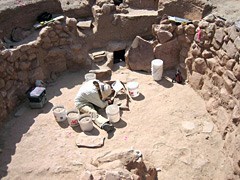
NPS Photo.
Federal agencies, the State of Hawai'i, Indian Tribes, and Native Hawaiian organizations must protect Native American human remains or cultural items on Federal or Tribal lands. This requirement took effect with the passage of NAGPRA on November 16, 1990, and the related process only applies to Federal or Tribal lands. Native American human remains and other cultural items removed from Federal or Tribal lands belong, in the first instance, to lineal descendants, Indian Tribes, or Native Hawaiian organizations.
For a more in-depth look at the entire process, read Subpart B of the regulations (43 CFR Part 10).
What must be done?
Any person who knows or has reason to know of a discovery of human remains or cultural items on Federal or Tribal lands must immediately report the discovery to the responsible appropriate official. Any activity on Federal or Tribal land that is near the discovery must immediately stop until the activity is certified to resume.
When a Federal agency or the State of Hawaii Department of Hawaiian Homelands (DHHL) has responsibility for a discovery or excavation on Federal or Tribal lands, a plan of action is required. A plan of action is not required when an Indian Tribe or Native Hawaiian organization has responsibility for a discovery or excavation on Tribal lands. A plan of action requires the following steps:
Step 1 - Initiate consultation. Before a planned activity or after a discovery, the Federal agency or DHHL must identify consulting parties and invite the parties to consult.
Step 2 - Consult on the plan of action. The Federal agency or DHHL must consult on the plan of action and prepare a record of consultation that describes the concurrence, disagreement, or nonresponse of the consulting parties to the content of the plan of action.
Step 3 - Approve and sign the plan of action. The Federal agency or DHHL must approve and sign a plan of action and must provide a copy to all consulting parties.
What else must be done?
Human remains or cultural items removed from Federal or Tribal land are subject to disposition in a specific priority order. After identifying and informing the appropriate parties from the priority list, a Notice of Intended Disposition must be published in the Federal Register. Any human remains or cultural items that are not claimed after a notice must be reported as unclaimed human remains or cultural items.
What if a discovery or excavation is NOT on Federal or Tribal lands?
On private or state land, discoveries or excavations are governed first by local or state laws, but human remains or cultural items removed from private or state land may be subject to repatriation under NAGPRA, depending on who has control of them. An online compilation of state burial laws is a useful starting point for determining what local or state laws might apply and who has control.
Last updated: January 11, 2024
